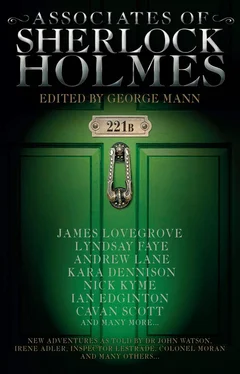Here Mr Holmes cut in, “Are you sure this fellow was not deceiving you, Miss Stoner? Tibet has forbidden foreigners from crossing its borders for the past three decades. Violating that ban by entering through such a conspicuous point of ingress as the Mana Pass leaves me suspicious.”
I replied, “I can only relate what I was told, Mr Holmes, and he did say that he had been turned back in an earlier attempt. But Mr Thurn informed me, without any apparent boastfulness, that he was masterful at disguise.”
“He rather reminds me of you in that regard,” Dr Watson said to his friend.
“He also claimed rather provocatively that he had developed the means of going unseen, though he did not elaborate on what he meant by that.”
Mr Holmes said, “The thought of his actually succeeding in penetrating Tibet is intriguing. I have long desired to travel there myself, and one day may attempt it. But again I apologise. Please resume your account.”
I did so. “Mr Thurn went on with his personal history, saying, ‘Though anyone who aids a foreigner who has infiltrated Tibet runs the risk of punishment, including death, I nevertheless met people who, having lived all their lives in so isolated a region, were as fascinated by me as I was by them. I spent two years in Tibet, during which I devoted most of my time to the study of Buddhism. I was fortunate in impressing with my earnestness a gomchen , a Tibetan hermit said to be capable of working wonders, who at great risk accepted me as his secret student. It was he who taught me how to conjure seemingly living entities with my mind.’
“‘I do not understand,’ I told him.
“He said, ‘I warned you that it would be difficult for you to accept. Nevertheless, what I am telling you is the truth. It is possible for one to materialise a form the Tibetans call a tulpa , which is a manifestation of thought with the appearance of a living being, brought about through intensely focused concentration. It is an illusion, but not a delusion; a hallucination so convincing that not only does the conjurer himself witness it but, ideally, it would be visible to others as well, this phantom construction as perceptible as an authentic material entity. A tulpa might even, ultimately, take on a personality of its own and defy its master’s direction, living so to speak as an independent being.’
“‘Are you suggesting,’ I said, ‘that the snake…’
“‘Not only the snake,’ he answered. ‘I manifested the baboon and the cheetah, too, purely through the power of thought. They were not sent physically from India. It was my mind that sent them here at Dr Roylott’s behest. During our correspondence after I had left Tibet I told your stepfather of my experiences there and my own success in conjuring tulpas , and he was thoroughly intrigued. We devised an experiment: would I be able to manifest a tulpa remotely, by transmitting the power of my thoughts to his location in England, with the doctor acting as a sort of receiver to supplement my efforts? Would it be possible to create a tulpa through such a joint effort? Oh, of course the conjurations were mostly mine, but your stepfather’s belief in my efforts, and his concentration on the subjects we chose as our models, helped enable them to manifest, and after they had done so it was mostly through Dr Roylott’s own will that these forms were sustained. With these things, belief is all, a belief more complex than the blind faith of religion, because one is always aware that the object of belief is an illusion.
“‘First I created the baboon, based on mental images of creatures I had seen in South Africa. Shortly after, I manifested the cat, patterned after the Asiatic cheetah. It was not until later that Roylott specifically requested a dangerous serpent. I did question why he should want this particular creature, and his response was that it would render our ongoing experiment all the more fascinating. Would a mouse, for instance, seemingly struck by the fangs of this snake believe so in the creature’s veracity and its non-existent poison that it would perish as a result? Have you heard of the aborigines of Australia and their bone pointing? How one of them so cursed will die purely from their belief in the magic?’
“‘This is preposterous,’ I protested. ‘This snake drank milk, proving that it required sustenance as a physical creature. It could not have been an illusion. I am not calling you a liar, sir, and I believe at least that you yourself believe in such things, but my stepfather must have acquired actual animals from another source if not from you.’
“‘Miss Stoner,’ he said, with his black eyes burning into me, ‘snakes do not care to drink milk. If your stepfather put a saucer of milk in front of it, it was only a prop to help him continue to think of the snake as an actual creature, and a loyal pet. Summoning a snake by whistling? As a snake does not hear as we do, I am doubtful one might be trained in such a manner. Again, something Roylott did only to convince himself that his snake was real and obedient to him. I hardly believe that an actual snake could climb a bell pull, so as to lower itself to your sister’s bed and back again, but this snake did so because your stepfather imagined that it could. In as much as he was able, he was controlling those beasts. Why, I ask you, do you think the baboon and cheetah, which could easily have passed over the wall of your property here, did not do so? And, incidentally, there is no such animal as a swamp adder. Oh, infrequently the African swamp viper may be called that, but its venom is not nearly as toxic as that I imagined for the cobra-like snake I invented for Dr Roylott. Creating an animal that did not truly exist, based on the attributes of a number of snakes, was another aspect of the proposed experiment. I gave it the fanciful name of swamp adder, and it is interesting to learn that the appellation suggested itself spontaneously to the sensitive mind of your friend Mr Holmes.’
“I said, ‘But if my stepfather knew all along that the snake was not real, why then did he himself succumb to its bite when it was frightened by Mr Holmes back into Dr Roylott’s chamber?’
“Mr Thurn said gravely, ‘In order for the snake to successfully kill you, Miss Stoner, at that moment your stepfather believed in its existence with all of his might. Without my level of training, he could not balance his belief with his awareness of the illusion. His instinctual fear of a snake attacking him leant the manifestation potency. No poison entered him. It was his own mind that killed him.’
“‘Yet how,’ I asked, ‘would this have worked on my sister, who never knew it was a snake that attacked her? She could not die of imagined poisoning if she did not take in the illusion of a snake at more than a glance. She referred to it only as a speckled band.’
“He said, ‘Grimesby Roylott was a man of great willpower; it is why our experiment was so successful. His will that your sister should die transmitted itself to her mind, almost in the way of a powerful hypnotic suggestion. It was not the snake that killed her, not even an illusory snake, so much as the sheer malevolent force of his own mind. He had no fear of puncture wounds being found on her flesh, because there would be none. You told me your first impression regarding your sister’s demise was that she had died of fear. This was essentially true.
“‘Those three animals were extensions of your stepfather’s will; that is why they were sustained and were so convincing. And from what I have now learned from you, seeing my complicated old friend in a new light, I suspect it was not only to frighten villagers away from his property that he let the baboon and cheetah roam free, but to frighten you and your sister from venturing outside. To keep you prisoners here. I cannot help but wonder if it was not only the money he would lose once you two should marry that caused him to react in so brutal a manner, but fear that you two, upon going into the world, would inform others of his behaviours.’
Читать дальше












